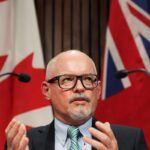In a bold vision that could reshape Canada’s economic landscape, Saskatchewan Premier Scott Moe is advancing an ambitious proposal for a northern trade corridor spanning the nation from west to east. The sweeping infrastructure project would create a vital transportation artery connecting the Pacific and Arctic coasts, potentially transforming how Canadian goods move across the country and to international markets.
The “Port-to-Port Corridor” concept, unveiled during Premier Moe’s recent economic development tour, envisions a comprehensive network of railways, highways, and utility corridors stretching across Canada’s northern regions. This transportation backbone would link existing deep-water ports while potentially spurring development of new facilities, particularly along the resource-rich but infrastructure-poor Arctic coastline.
“What we’re talking about is a generational opportunity to unlock Canada’s economic potential,” Moe explained during a presentation to business leaders in Saskatoon. “This isn’t just about moving Saskatchewan potash or grain more efficiently—it’s about creating a strategic corridor that benefits all provinces while strengthening our national sovereignty in the North.”
The proposal comes at a critical juncture for Canada’s economic future. With increasing global trade tensions and growing competition for resource markets, experts suggest Canada must diversify its export routes beyond traditional southern corridors. A northern alternative could provide crucial redundancy while opening access to Asian markets via both Pacific and Arctic shipping lanes.
Economic analysis commissioned by the Saskatchewan government indicates the corridor could generate up to $135 billion in new economic activity over the next two decades while creating approximately 28,000 construction jobs and 5,600 permanent positions. However, the estimated price tag—between $75 billion and $100 billion—represents a formidable challenge requiring federal partnership and private investment.
Federal Transport Minister Pablo Rodriguez has acknowledged receiving the proposal but indicated it requires thorough evaluation within broader national infrastructure priorities. “We appreciate Premier Moe’s vision, and we’re examining how it aligns with our existing Northern transportation strategy,” Rodriguez stated. “Any project of this magnitude demands rigorous assessment of economic benefits, environmental impacts, and Indigenous consultation.”
Indigenous leaders across the potential corridor route have expressed mixed reactions. While some see unprecedented economic opportunities, others voice concerns about environmental impacts and insufficient consultation.
“First Nations must be true partners from day one, not afterthoughts,” emphasized Grand Chief Alvin Fiddler of the Nishnawbe Aski Nation. “We recognize the potential benefits, but any corridor crossing traditional territories must respect Indigenous sovereignty and provide meaningful equity participation.”
The proposal has gained traction beyond Saskatchewan, with Alberta Premier Danielle Smith and Manitoba Premier Wab Kinew expressing preliminary support. Business councils across Western Canada have also endorsed the concept, with the Canada West Foundation calling it “the most significant nation-building infrastructure initiative since the transcontinental railway.”
Environmental organizations, however, urge caution. “The ecological footprint of a project this size requires extensive impact assessment,” notes Jennifer Winter, environmental policy analyst at the University of Calgary. “While improved transportation efficiency could reduce emissions per ton of cargo, we must consider the cumulative effects on northern ecosystems and permafrost integrity.”
Economic experts suggest the corridor could fundamentally alter Canada’s trade patterns. “Right now, approximately 75% of our exports flow south to the United States,” explains Trevor Tombe, economist at the University of Calgary. “A northern corridor creates east-west alternatives that reduce our economic vulnerability while potentially opening new markets across the Arctic.”
As federal and provincial leaders consider next steps, the corridor concept has sparked a broader national conversation about Canada’s infrastructure needs in a changing global economy. With Arctic shipping routes becoming increasingly viable due to climate change and resource development pushing northward, the proposal represents a strategic bet on Canada’s northern frontier.
As this transformative proposal moves forward, Canadians must ask: Is this ambitious vision the key to unlocking our nation’s economic potential in the North, or does it represent an oversized gamble with uncertain returns? The answer may well determine Canada’s economic competitiveness for generations to come.
























